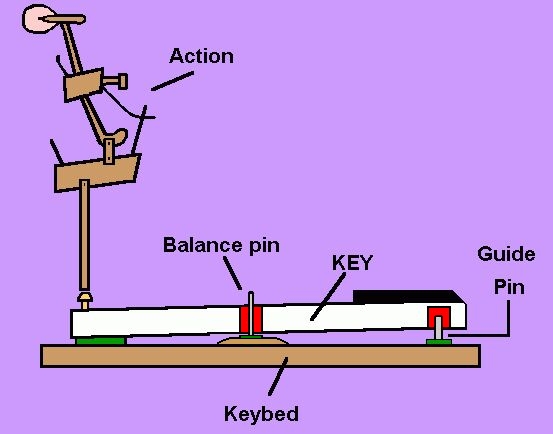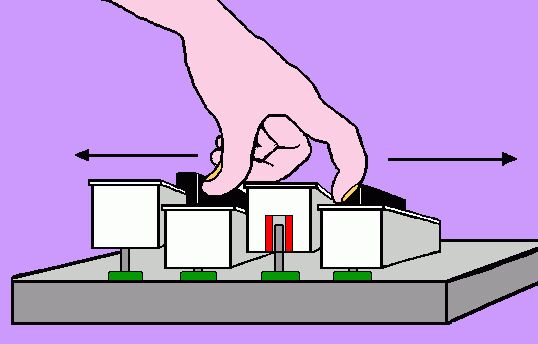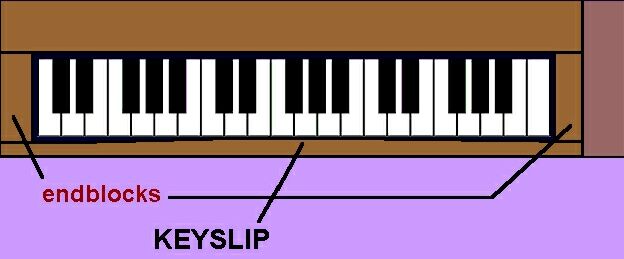 Unfortunately, it may not be readily apparent whether the cause of a sticking key is in the piano action or the key itself. To determine this it is necessary to have access to the action, usually calling for the service of a professional tuner.
Unfortunately, it may not be readily apparent whether the cause of a sticking key is in the piano action or the key itself. To determine this it is necessary to have access to the action, usually calling for the service of a professional tuner.
Piano keys can stick down or become sluggish for a seemingly infinate array of reasons including, but certainly not limited to; foreign objects caught between the keys (check the links to retrieving foreign objects from piano actions), jammed or broken interior action parts, warped keys rubbing together, broken keys, and a whole variety of causes associated with moisture. Unfortunately, it may not be readily apparent whether the cause of a sticking key is in the piano action or the key itself. To determine this it is necessary to have access to the action, usually calling for the service of a professional tuner.
Unfortunately, it may not be readily apparent whether the cause of a sticking key is in the piano action or the key itself. To determine this it is necessary to have access to the action, usually calling for the service of a professional tuner.
However, a common cause of keys that stick down (or fail to sound the note on a repeated stroke) is moisture in the key bushings, and you may be able to correct this yourself. As can be seen in the cross section drawing, the key is guided in its up and down motion by two metal pins extending up from the keybed; a balance pin in the center of the key (at the balance point where the key rocks on a falcrum), and a thicker guide pin near the front of the key which serves to keep the key from wobbling sideways. Both pins extend through channels in the key which are lined with a thin felt bushing cloth (shown in red in the drawings). Although the balance pin rarely causes much problem, the guide pin can be quite troublesome, especially in very humid conditions. Even a small amount of moisture trapped in the bushing can swell the felt and cause it to grip the pin too tightly. The result can be a key that either sticks down, or fails to return on the upstroke enough to allow the action parts to get back into position for a repeat stroke. This is a frequent condition on new pianos since the bushings are a very tight fit to begin with, in order to allow for eventual wear.
Sometimes the pin can be freed by slightly compressing the bushing by hand. Grab the key at the front and move it laterally back and forth (as indicated by the arrows in the following drawing) to press the pin against the felt. Naturally you cannot see the pin without removing cabinet parts, but if you attempt to move the key sideways you will feel the resistance of the guide pin. Do not apply great pressure, but slowly and firmly move the key back and forth several times and press the pin against the felt to compress it. On white keys you may use moderate pressure since the wood in the key is quite thick, but remember the point is to compress the felt bushing, not the key wood. Also be very cautious when  applying this technique to the black keys; the wood is much thinner in these keys and too much pressure could risk cracking the wood. The object here is to just compress the felt enough to free the guide pin. If moving the key laterally three or four times doesn't do the trick, forget it. The problem is probably elsewhere. When there is only a bit of moisture in the felt bushing this procedure is very often successful. However, if there is too much swelling of the felt, or the problem is in the action, you will be obliged to call a piano tuner and have the key removed and the bushing compressed with a special tool (instructions for doing this, incidentally, along with many others for dealing with sticking keys and sticking action parts, is fully described and illustrated in YOU CAN REPAIR AND REGULATE YOUR OWN PIANO which can be ordered by mail, along with a set of regulation tools). If sticking keys are a consistent problem with your piano, an inexpensive dehumidifer, item 9 in the tools section, installed inside the piano will probably solve the problem. Your piano tuner can install one for you or you can order it by mail and install it yourself.
applying this technique to the black keys; the wood is much thinner in these keys and too much pressure could risk cracking the wood. The object here is to just compress the felt enough to free the guide pin. If moving the key laterally three or four times doesn't do the trick, forget it. The problem is probably elsewhere. When there is only a bit of moisture in the felt bushing this procedure is very often successful. However, if there is too much swelling of the felt, or the problem is in the action, you will be obliged to call a piano tuner and have the key removed and the bushing compressed with a special tool (instructions for doing this, incidentally, along with many others for dealing with sticking keys and sticking action parts, is fully described and illustrated in YOU CAN REPAIR AND REGULATE YOUR OWN PIANO which can be ordered by mail, along with a set of regulation tools). If sticking keys are a consistent problem with your piano, an inexpensive dehumidifer, item 9 in the tools section, installed inside the piano will probably solve the problem. Your piano tuner can install one for you or you can order it by mail and install it yourself.
Another obvious, though often overlooked source of sticking keys, particularly on new pianos where the wood is still curing, is a warped or out of position KEYSLIP. The keyslip is the thin strip of wood which runs parallel with the keyboard in front of the keys (see drawing below). The distance between this strip and the keys is quite close, an eighth of an inch or less. Occasionally moisture will swell the wood, or a player inadvertently press against the keyslip and move it enough forward to rub against the keys. Though this problem occurs on all model pianos, it is especially common on grands where the keyslip is separate from the piano case so as to be removeable to allow the action to be taken out of the piano. Sometimes all that is required is to grip the keyslip with your fingertips and gently pull it back toward you. If the wood is too badly warped it may be necessary to loosen the screws under the keybed and apply cardboard shims between the keyslip and endblocks to space it away from the keys.

Another (admittedly more desperate) measure to remove moisture from the key bushings you may wish to try before calling the tuner is to use heat from a portable hair drier. Put the drier blower on high and move it laterally across the front of the keys and keyslip for five or ten minutes, or until you tire of the whole thing. Sometimes the heat will dry out the bushing and free the key. It's worth a try anyway.